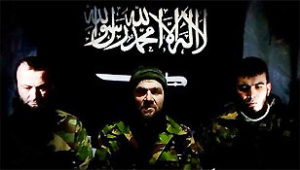What has he been doing since his release 10 years ago? Planning and recruiting for the Istanbul airport terror attack? And Obama released 3 detainees in 2 days and more to come. What about those ‘forever’ detainees like Khalid Sheik Mohammed? Hummmm
Ex-Gitmo detainee, Islamic State’s leader in Chechnya designated by State Department
The State Department announced today that two jihadists have been added to the US government’s list of designated terrorists.
One of the two, Ayrat Nasimovich Vakhitov, was once detained at Guantanamo and was recently arrested by Turkish authorities. According to Voice of America, Vakhitov is “among 30 people Turkish authorities say they have arrested in connection with” the terrorist attack at Istanbul’s Ataturk airport late last month. No terrorist organization has claimed responsibility for the assault on the airport, which left more than 40 people dead. But it is widely suspected to be the work of the Islamic State.
The second newly-designated terrorist is Aslan Avgazarovich Byutukaev, who leads the jihadists in Chechnya who are loyal to the Islamic State’s so-called Caucasus province.
Former Guantanamo Detainee
Vakhitov (pictured on the right) was held at Guantanamo for less than two years, from June 2002 until February 2004. He was then transferred to Russia. The State Department’s designation page does not say that Vakhitov was once detained at the American facility in Cuba, but The Long War Journal has confirmed that he is the same individual.
The details of his story, as recounted in a leaked Joint Task Force – Guantanamo (JTF-GTMO) threat assessment, are somewhat odd. Vakhitov was “arrested by the Taliban on suspicion of espionage, and incarcerated at the Sarpuza prison complex in Kandahar,” the leaked file reads. He was apparently transferred to Guantanamo because of “his possible knowledge of an American citizen killed” at that same prison “while he was there.”
JTF-GTMO ultimately concluded that Vakhitov was neither affiliated with al Qaeda, nor a Taliban leader. He was recommended for transfer. But JTF-GTMO also thought he would be remain imprisoned inside Russia.
“Because of the Russian government’s agreement to incarcerate this detainee upon his transfer, and provided that he remains incarcerated under the control of the Russian government, the detainee poses no future threat to the U.S. or its allies,” JTF-GTMO’s threat assessment reads.
The State Department says that Vakhitov “is associated with Jaysh al-Muhajirin Wal Ansar” (JMWA, or “the Army of the Emigrants and Helpers”). Part of the original JMWA organization joined the Islamic State, while the rest of the organization continued to operate independently before swearing allegiance to Al Nusrah Front in Sept. 2015. Al Nusrah is al Qaeda’s official branch in Syria and the Islamic State’s rival.
The State Department’s designation page does not mention Vakhitov’s reported arrest in Turkey, but does say he has “used the internet to recruit militants to travel to Syria.”
Islamic State leader in Chechnya
The State Department note Byutukaev was a “prominent leader” in the Islamic Caucasus Emirate (ICE). ICE is openly loyal to al Qaeda, but has suffered a string of defections to the Islamic State.
Russian security forces killed ICE’s top emir and his two successors in less than two years time, from late 2013 until mid-2015. The decapitation strikes likely helped the Islamic State win the loyalty of some of ICE’s most important remaining commanders, including Byutukaev.
Byutukaev, also known as Emir Khamzat, was a close confidant of Dokku Umarov and led ICE’s Riyad-us-Saliheen Martyr Brigade. But Umarov perished sometime in late 2013 or early 2014. His replacement, Aliaskhab Kebekov, more commonly known as Ali Abu Muhammad al Dagestani, was subsequently killed by Russian forces in April 2015.
Less than two months after Kebekov’s demise, Byutukaev officially broke with ICE, declaring himself to be one of Baghdadi’s men.
The pro-al Qaeda contingent in the Caucasus then suffered another blow when Abu Usman, Kebekov’s successor, was hunted down in August 2015. Both Kebekov and Abu Usman were vocal opponents of Abu Bakr al Baghdadi’s Islamic State, so much so that al Qaeda’s main propaganda arm continues to feature clips of their anti-Baghdadi lectures in its productions.
High value targeting, as it is commonly called, is an essential part of any government’s counterterrorism strategy. But it can lead to unintended consequences as well. In this instance, the deaths of ICE’s top leaders probably helped drive Byutukaev and his comrades into the Islamic State’s arms. The large contingent of fighters from the Caucasus region in the Islamic State’s ranks in Iraq and Syria most likely added to the pressure on the jihadists back home to flip as well.
The State Department notes that Byutukaev is “responsible for directing numerous deadly suicide bombing operations, including the January 2011 attack at the crowded international arrivals hall of Moscow’s Domodedovo Airport.” The bombing killed at least 35 people and wounded more than 100 others.
Umarov, who was ICE’s emir at the time, quickly claimed credit for the airport attack in a video released online.
Umarov also appeared in another video alongside Byutukaev (seen on the left in the photo included here) and a suicide bomber identified only as “Saifullah.” Umarov said that he had visited the Riyad-us-Saliheen Martyr Brigade’s base before sending Saifullah on a “special operation,” meaning the bombing at Domodedovo.
At the end of video, both Umarov and Byutukaev were shown embracing Saifullah. [See LWJ report, Caucasus Emirate leader threatens Russia with ‘a year of blood and tears.’]
“Since becoming an ISIL [Islamic State in Iraq and the Levant] leader in June 2015,” State reports, “Byutukaev has planned attacks on behalf of the group.” One of these operations took place in November 2015, when “Russian Special Forces discovered a large bomb hidden on the side of the road in Kantyshevo, Ingushetiya, Russia.”
The Caucasus “province” was announced in June 2015, after Islamic State spokesman Abu Muhammad al Adnani publicly accepted the oaths of allegiance sworn by jihadists throughout the region. The Caucasus branch is reportedly led by Rustam Asilderov, a former ICE leader who defected to the Islamic State in late 2014. Asilderov’s defection set off a firestorm of controversy and bickering among the Caucasus jihadists.
In Sept. 2015, Foggy Bottom designated the Islamic State’s Caucasus “province” as a terrorist organization and also identified other ICE defectors who had joined its cause.
On May 15, 2006 the Department of Defense released its first full official list of all the Guantanamo detainees who were held in military custody.[3] Airat Vakhitov’s name is not on that list. The list includes an individual named Aiat Nasimovich Vahitov.who was born on March 27, 1977, on Naberezhnye Chelny, Tatarstan, Russia.
Russian authorities released the detainees after investigations into whether they had broken any Russian laws.
Vakhitov spoke publicly on June 28, 2005 about torture in Guantanamo when he announced he was planning to sue the United States for his mistreatment.[4] He was invited, by Amnesty International, to speak about Guantanamo torture, in London, on November 2, 2002.
Geydar Dzhemal, chairman of the Islamic Committee of Russia, reported that he was hosting Vakhitov, and another former Guantanamo detainee, Rustam Akhmyarov, following threats by security officials.[5] According to Dzhemal the security officials had visited Vakhitov, and warned him that he should only talk about torture in Guantanamo Bay, not Russian torture. Dzhemal reported that security officials subsequently seized Vakhitov and Akhmyarov from his apartment on August 29, 2005. He called their seizure a kidnapping because they refused to show their identification. He predicted that the pair would be arrested on trumped up charges, to curtail their human rights activities.
The pair were released from detention on September 2, 2005 More details here.


